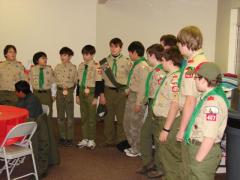 Every now and then, I have a chance to visit another troop, and when I do, I observe how they operate compared with other troops (and our own). I pay attention to who is leading – the Scouts or the adults; I look to see what the adults do during the troop meetings; I observe the structure of the troop meeting and how the patrols are organized. But one thing I always notice is the way the Scouts and adults are dressed.
Every now and then, I have a chance to visit another troop, and when I do, I observe how they operate compared with other troops (and our own). I pay attention to who is leading – the Scouts or the adults; I look to see what the adults do during the troop meetings; I observe the structure of the troop meeting and how the patrols are organized. But one thing I always notice is the way the Scouts and adults are dressed.
In nearly every troop, all the Scouts and Scouters are in uniform. By uniform, of course, I mean the complete Scout uniform: Scout pants or shorts and shirt (usually with neckerchief – I have yet to see a troop that doesn’t wear them), Scout socks when shorts are being worn, and occasionally a BSA or unit hat or cap (which I feel should not be worn indoors). On occasion, though, the boys in a troop will be in jeans or other pants, or in troop or other Scouting t-shirts, or not in any Scout garb at all.
Personally, I believe that you are not really a Scout troop if your boys and adults are not in uniform. Why is this? Well, ask yourself if you’d still be a Scout troop if you don’t do advancement, or go camping, or have elected youth leaders. Of course you wouldn’t! These are the core methods of Boy Scouting which define our movement and our program – and, guess what? Uniforming is one of those methods, and just as you can’t decide to stop doing advancement, you can’t decide to abandon the uniform.
Some troops believe it’s OK to allow the boys to decide whether to wear uniforms or not. After all, Scouting is boy-led, right? Well, that’s one thing that Scouting simply doesn’t give them a choice in, just as Scouting doesn’t allow the boys to abandon the patrol method.
There are many other reasons for uniforming. Your Scouts act more like Scouts and less like typical random middle-school kids when they are in uniform. It’s easy to identify who is in which patrol and who the youth leaders are. Any visitors who happen upon your troop meeting will know immediately that you are a Boy Scout troop and not just a bunch of boys. Â And, of course, it makes it easier to know who your Scouts are.
Of course, there are times when a BSA or troop t-shirt is appropriate, such as at summer camp, on hikes and campouts, or when doing service. Naturally, these are times when the boys are likely to get dirty or are physically active. But the best troops are uniformed at troop meetings as a matter of course – they don’t even give it a second thought.
What if you have Scouts for whom buying a uniform is difficult? These same troops, and many others, have a supply of previously-worn uniforms that were donated back to the troop by Scouts who have outgrown theirs. If you don’t, why not start a uniform bank? And, if you are fortunate enough to be in a more affluent area, why not share your uniform bank with a less privileged troop? “A Scout is helpful” and “A Scout is thrifty” are great reasons to do this.
And what of the boys who really want to choose their own uniforms? This is one of the “carrots” of the Venturing program, where crews can choose their own uniform, be it the official Venturing shirt and pants or a uniform of their own choosing. Once they turn 14, they can join a Venturing crew that chooses an alternate uniform.
If you’re one of those troops where the boys don’t look like Scouts, get with the program – get in uniform and enjoy the benefits of this essential method of Scouting.
This post first appeared on Bobwhite Blather.


